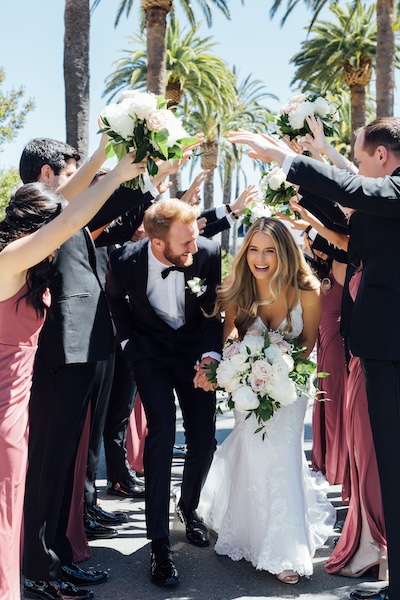Business + Marketing
How to Submit Wedding Photos to Publications in a Changing Media Landscape
June 15, 2021
There’s no denying the benefits of a robust editorial submission strategy as a wedding photographer. The opportunity for exposure in front of your ideal clients is invaluable on its own. Toss in some third-party validation and a chance to nurture your network, and you’ve got yourself a winning deal. Splendid Insights, a global wedding market research firm, agrees, noting that submitting wedding photos to publications is one of the top ways couples find their wedding-day dream team.
But, there’s one perk that is often overlooked: submitting wedding photos can be a powerful tool for photographers to position themselves as thought leaders. If you want to carve out your role as an expert in South-Asian weddings, for example, or as a go-to resource for second weddings with blended families, you can align your submissions with that direction in mind.
[Read: Navigating the Micro Wedding for Your Photo Business]
Yet, with the pandemic, a lot has changed in the media world and photographers need to shift their approach to ensure they continue to lead their businesses in the right direction when they submit wedding photos to publications. While many publications are recovering from a content drought and their priorities have shifted (impacting the type of material they accept), others have taken different paths during the pandemic.
Keep these best practices in mind as you prepare to submit your wedding photos to publications in 2021 and beyond:
1. Research before you submit wedding photos to publications.
Every outlet has a niche, whether it’s a certain aesthetic, location or event style. Review a publication’s Instagram page, website or blog to ensure your submission will fit in with the rest of the content they post. This also helps you confirm whether they are a fit for your brand!
[Read: How to Get Weddings and Portraits Published in a Major Publication]
Bear in mind that blogs and publications come and go, so these days, it’s especially important to determine if the media outlet is still regularly publishing. Review their features and social media posts to ensure they have ongoing content—otherwise, their long-term viability may be in question.
2. Consider cultural relevancy.
A beautiful wedding is reason enough to submit, but editors are particularly keen to see submissions that are relevant to the times. Showcasing pandemic-friendly solutions and micro weddings will provide them with content that captures the current state of the industry. Likewise, diversity has been a growing focus in the media, with many national outlets making public commitments to be more inclusive.
3. Follow wedding photo submission guidelines to a T.
Most outlets have a specific page that outlines what they are looking for, how to submit wedding photos to publications and all of the information you need to provide in your submission. Make sure you are meeting 100 percent of the parameters—not 99 percent. An incomplete or incorrect submission could cost you the feature.
4. Respect exclusivity requirements as you submit wedding photos to publications.
Some publications are exclusive, meaning they require first rights to feature a wedding. If you’re interested in submitting to an exclusive publication, choose your very best wedding and save it for them. If it doesn’t get accepted, you can move on to your second choice.
The main thing you want to avoid is getting caught submitting the same event to multiple exclusive outlets and harming your relationship with editors. Likewise, if other members of the wedding team have an interest in submitting, make sure you have been clear with your intentions and do not approve another submission if yours are in the works.
5. Connect with your couple first.
Even if submission rights are in your photography contract, it’s essential to check in with clients to ensure they’re okay with it. Some publications will reach out to the couple directly for insight, so it’s best to give them a heads up so they can be ready. It’ll give them a chance to mull over their favorite details and moments—something every newly married couple loves to do!
6. Curate your gallery.
Editors know you take a lot of great pictures at any given wedding, but that doesn’t mean they need to see them all. Most publications specify how many images they require, so do not send a gallery link with over 1,000 photos for them to sift through.
Cull it down to meet their guidelines and organize them in chronological order to follow the flow of the day. Focus on the details, highlighting everything that made the wedding unique and special. The goal is to make it as easy and efficient for an editor to look through your photos and fall in love.
7. Do well by your vendor team as you submit wedding photos to publications.
Wedding submissions are exciting for everyone involved, so it can be a great way to bond with the other vendors from the event.
[Read: How to Fill Your Calendar with Dream Wedding Clients]
Make sure you include everyone who had a hand in the day and confirm that their company names, website URLs and social media handles are all accurate. That way, you can ensure everyone is credited properly without making the editor go on a wild goose chase.
8. Promote your feature after you submit.
Editors love to share your work, but they love it even more to see when the promotion is reciprocated! Choose a favorite photo from the wedding, write a thoughtful caption, and tag the publication and all of the vendors. The more you share, the better a feature does, meaning more eyes on your work. Bonus: Editors will be more inclined to feature you again when they know you’ll shout a feature from the rooftops!
[Read: Shooting For Exposure—Getting Portraits into Publications, on Billboards and Gallery Walls]
As you ramp back up in business, make sure you are setting aside time to get those submissions out. Make prepping your submissions part of your wedding workflow. It’s easier to set aside an hour or two each week to submit wedding photos to publications than to face down a backlog of events at the end of a season. When you put in consistent effort, you will see consistent results. It’s as simple as that.
Meghan Ely is the owner of wedding PR and wedding marketing firm OFD Consulting. She is a sought-after speaker, adjunct professor in the field of public relations, and a self-professed royal-wedding enthusiast.




